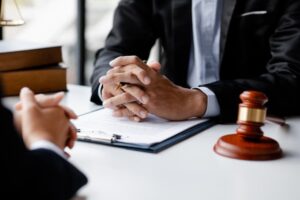What Are the Steps in a Personal Injury Lawsuit?
What Are the Steps in a Personal Injury Lawsuit?
Personal injury claims and lawsuits arise when other individuals and entities are negligent. Ordinarily, a party is negligent when they fail to act as a hypothetical reasonable person will act in the same or similar situation.
When others are negligent, various types of accidents can occur, including motor vehicle collisions, pedestrian, bicycle, and premises accidents.
An experienced personal injury lawyer can first submit a claim to the at-fault party’s insurance company on your behalf and attempt to settle your case favorably.
However, if the insurance company denies fault for the accident or refuses to offer fair settlement compensation, your attorney can file a personal injury lawsuit for you.
After filing a lawsuit in your case, settlement negotiations may continue. However, your lawyer must follow additional steps to ensure your case moves through the system efficiently.
Your attorney will do everything they can to resolve your personal injury case promptly and ensure you receive the full financial recovery you deserve.
Types of Personal Injury Cases

Personal injury cases encompass a broad spectrum of incidents that harm an individual, often due to someone else’s negligent or intentional actions. Among the common types of personal injury cases, car accidents top the list.
These incidents can lead to severe injuries and property damage, with factors like speeding, distracted driving, or impaired driving contributing to their occurrence.
Truck accidents represent another significant category, typically involving large commercial vehicles, like big rigs and tractor-trailers, with potentially catastrophic outcomes. Due to their size and weight, truck accidents often result in serious injuries and extensive damage.
Determining liability in these cases can involve multiple parties such as the truck driver, the trucking company, and potentially others.
Motorcycle and bicycle accidents pose unique risks due to the limited protection for riders. Collisions involving these vehicles can lead to severe injuries and usually result from reckless driving maneuvers by others and poor roadway conditions. Similarly, pedestrian accidents involve individuals on foot and can result in significant injuries when drivers fail to yield the right-of-way at the appropriate times – especially at traffic intersections.
Workers’ compensation cases arise when employees suffer injuries or illnesses. These cases focus on obtaining compensation for medical expenses and lost income. Workplace accidents can range from slip-and-falls to more severe incidents in industrial settings.
Personal injury cases cover a wide range of scenarios, each requiring a unique approach to establish liability and seek favorable compensation. Whether it’s a car, truck, motorcycle, bicycle, or pedestrian accident – or an incident leading to a workers’ compensation claim – understanding the specific nuances of each case is crucial for pursuing justice and securing rightful compensation for the affected individuals.
Injuries That Accident Victims Frequently Suffer
Accident victims, facing the repercussions of others’ negligence, often endure a myriad of injuries that can significantly affect their physical well-being and overall quality of life.
Among the common injuries arising from such incidents are traumatic brain injuries (TBIs), which can result from the force of a collision and lead to cognitive impairments and long-term mental health complications.
The trauma and blunt force associated with an accident can also damage internal organs, leading to internal bleeding or organ failure. These injuries may require prompt medical attention to prevent further complications.
Whiplash, commonly associated with motor vehicle crashes, occurs when the accident victim’s neck moves abruptly backward and forward, causing headaches and stiffness and affecting the victim’s daily activities.
Soft tissue injuries, fractures, and broken bones are also prevalent in various accidents. Collisions’ sudden and forceful nature can lead to fractures, while soft tissue injuries, such as sprains and strains, can result from an abrupt backward and forward motion.
Spinal cord injuries represent another serious consequence, often causing full or partial paralysis or impaired motor function. The severity of these injuries depends upon the specific location and extent of damage to the spinal cord, influencing the victim’s ability to perform daily living tasks and move.
Psychological injuries, such as emotional distress and post-traumatic stress disorder (PTSD), are also prevalent among accident victims. The emotional toll of experiencing a traumatic event can have long-lasting effects on an accident victim’s mental health, significantly affecting their ability to function daily.
If you suffered any of these injuries in an accident that resulted from someone else’s negligence, an experienced personal injury attorney in your area can help. Your lawyer can meet with you immediately to discuss your accident circumstances and develop a plan of action to move your claim or lawsuit forward.
Legal Elements of Proof in a Personal Injury Case
In a personal injury case, establishing liability requires a comprehensive examination of four key legal elements of proof. The first element demonstrates a duty of care owed by the at-fault defendant to the accident victim plaintiff.
This duty signifies the legal responsibility to act reasonably and avoid causing harm to others. For instance, drivers must drive safely in a car accident and follow all traffic laws.
The second element involves proving a breach of that duty. This showcases that the defendant failed to uphold their duty of care through negligent or intentional actions.
Negligence might involve behaviors like distracted driving, failing to maintain property, or insufficient safety measures. The breach of duty is a crucial link connecting the defendant’s actions to the harm the plaintiff suffered.
Causation forms the third element, establishing a direct connection between the defendant’s breach of duty and the plaintiff’s injuries. It requires demonstrating that the defendant’s actions were a substantial factor in causing the harm.
This can involve multiple contributing factors, and often requires professional testimony (such as from a certified accident reconstructionist) to establish the causal relationship.
The final element involves proving the damages that the plaintiff incurred. Damages encompass the measurable losses resulting from the injury, including medical expenses, lost income, property damage, and pain and suffering. Providing evidence of these damages is essential for assessing the compensation owed to the accident victim.
Successfully proving these four elements strengthens the plaintiff’s case, establishing a clear narrative of the defendant’s negligence, its direct effect on the victim, and the resulting harm and losses.
To construct a compelling argument, personal injury attorneys often gather evidence such as witness statements, medical records, professional testimony, and documentation of financial losses.
Meeting the burden of proof on these legal elements is vital for securing a favorable outcome in a personal injury case and ensuring that the injured party receives just compensation for their suffering and losses.
Litigation Steps Following an Accident
A personal injury lawsuit involves a series of well-defined steps aimed at seeking compensation for individuals who have suffered harm due to another party’s negligence or intentional actions.
The process begins with the initial consultation with a personal injury attorney, where the victim discusses the details of the incident, and the attorney evaluates the case’s merits.
Following this consultation, the attorney typically thoroughly investigates the circumstances surrounding the injury. This involves gathering evidence, obtaining witness statements, reviewing medical records and bills, and assessing any available documentation to substantiate the claim.
The goal is to build a strong case by establishing the at-fault defendant’s liability and the extent of the damages that the plaintiff accident victim suffered.
Once the attorney is satisfied with the gathered evidence, they draft and file a formal complaint, outlining the legal grounds for the lawsuit and the damages sought. The defendant then receives a copy of this complaint, officially initiating the legal process. In response, the defendant may file an answer, admitting or denying the allegations.
The next step involves the process of discovery, where both parties exchange information relevant to the case. This includes documents, witness statements, and other evidence that may support or challenge the claims made by either side. Depositions – or sworn statements taken under oath – may also go forward during this phase, allowing attorneys to question the witnesses and parties involved.
Either party may also file a pretrial motion to address legal issues or request specific actions from the court. Motions can include requests for summary judgment, which seeks a ruling based on the available evidence without going to trial.
If the case proceeds to trial, both parties will present their arguments and evidence before a judge and jury, including witness testimony, professional opinions, and other supporting materials. The judge or jury will then render a verdict. If the plaintiff prevails, the court will determine the compensation awarded based on the established damages.
Personal Injury Trials
A personal injury trial is a pivotal phase in the legal process where the dispute between the injured party (plaintiff) and the alleged wrongdoer (defendant) is presented before a jury to resolve the issues of liability and damages. The trial unfolds in several stages, each contributing to the case resolution.
The trial commences with jury selection through a process known as voir dire. Attorneys for both sides question potential jurors to ensure impartiality and select individuals who can objectively weigh the evidence presented at trial.
Following jury selection, the plaintiff’s attorney presents an opening statement outlining the case’s key points, followed by the defendant’s attorney. This sets the stage for introducing evidence, including witness testimony, documents (including medical records and bills), and professional opinions. The plaintiff bears the burden of proving the defendant’s negligence, causation, and the resulting damages.
Witness examinations, both direct and cross-examination, allow attorneys to present their case and challenge the credibility of opposing witnesses. Expert witnesses may provide specialized insights on complex issues like medical conditions or accident reconstructions.
After presenting evidence, both sides deliver closing arguments summarizing their positions. The judge proceeds to guide the jury on the pertinent legal principles and standards they should employ in reaching a verdict. The jury deliberates to determine whether the defendant is liable and, if so, the appropriate compensation for the plaintiff’s damages.
Types of Damages Available in a Personal Injury Case
In a personal injury claim or lawsuit, victims may seek various types of financial damages to compensate for the losses they incurred due to another party’s negligent or intentional actions. One primary category of damages is economic damages, which encompass tangible, measurable losses.

Medical expenses form a significant component of economic damages, covering costs related to hospitalization, surgeries, medications, rehabilitation, and other necessary healthcare services. Additionally, victims may seek compensation for future medical expenses if they anticipate ongoing treatment or care.
Lost income and loss of earning capacity are another crucial aspect of economic damages. In cases where the injury leads to a temporary or permanent inability to work, the victim can seek compensation for the income they will have earned during that period. This includes both past and future lost earnings.
Property damage, like damage to a vehicle in a car accident, is also recoverable as economic damages. The lawsuit can claim the quantifiable cost of repairing or replacing the damaged property, seeking fair compensation for the tangible losses.
In contrast, non-economic damages cover intangible losses that are challenging to quantify precisely. This category includes pain and suffering, emotional distress, loss of consortium, and loss of life enjoyment. These damages compensate victims for their injuries’ physical and emotional toll, acknowledging the non-financial aspects of their suffering.
Successfully pursuing a personal injury claim involves a thorough assessment of both economic and non-economic damages, ensuring that victims receive fair compensation for the full scope of their losses.
An experienced attorney plays a crucial role in evaluating and presenting these damages during negotiations or in court, seeking justice and redress for the injured party.
Talk With an Experienced Personal Injury Lawyer Right Away

Personal Injury Attorney, Keith More
An experienced personal injury attorney can aggressively advocate for your interests throughout a claim or lawsuit and work to secure the financial recovery you need.
If your case goes to trial, your lawyer can introduce evidence, make compelling arguments, and resolve your case in court.
Act soon to preserve your rights and seek the most compensation possible. Consultations are free, so call a law firm near you today.


